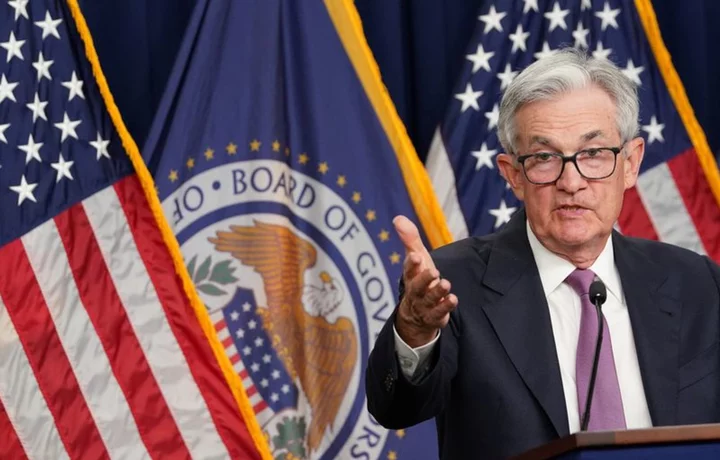By Howard Schneider
WASHINGTON Federal Reserve policymakers reached a milestone on Wednesday when they left the U.S. central bank's benchmark overnight interest rate steady for the first time after 10 consecutive hikes.
While Fed officials still see rates rising further, by as much as half a percentage point by the end of this year, the decision nonetheless marked a point of closure in their response to the economic fallout from the COVID-19 pandemic.
How did they get here?
Using the framework sometimes used to describe how people respond to tragic or unfortunate events, Fed Chair Jerome Powell's evolving language, since the first inkling of accelerating inflation in early 2021, tells the tale.
DENIAL
Inflation was still below the Fed's 2% target but beginning to rise when a prescient question from Los Angeles Times reporter Don Lee, about excess savings and possible excess spending, generated this response from Powell at his March 17, 2021 press conference: "It'll turn out to be a one-time sort of bulge in prices, but it won't change inflation going forward."
ANGER
This may be too strong a word for Powell's notoriously even-keeled public appearances. But his initial description of inflation as "transitory" quickly proved vexing, and at a press conference on July 28, 2021, he was asked pointedly what exactly he meant by it: "The concept of 'transitory' is really this. It is that the increases will happen. We're not saying they will reverse. That's not what 'transitory' means. It means that the increases in prices will happen, so there will be inflation but that the process of inflation will stop."
BARGAINING
At the Fed's annual Jackson Hole conference in Wyoming, Powell laid out systematically what he'd be watching to see if inflation was becoming more persistent. But he wasn't yet ready to give up his focus on healing the U.S. job market from the possible scars of the pandemic. In an Aug. 27, 2021, speech he kept the two sides of the Fed mandate in balance: "We know that extended periods of unemployment can mean lasting harm to workers and to the productive capacity of the economy. History also teaches, however, that central banks cannot take for granted that inflation due to transitory factors will fade."
DEPRESSION
In what was arguably a low point, once Powell laid out the criteria for assessing inflation, data on wages and other aspects of the economy promptly moved in the wrong direction. The introductory remarks at his Sept. 22, 2021 press conference read like a capitulation: "As the economy continues to reopen and spending rebounds, we are seeing upward pressure on prices, particularly because supply bottlenecks in some sectors have limited how quickly production can respond in the near term. These bottleneck effects have been larger and longer-lasting than anticipated, leading to upward revisions to participants' inflation projections."
ACCEPTANCE
By March 2022, the Fed had phased out its pandemic-era bond purchases and begun raising interest rates, but inflation kept accelerating. The Fed kicked its rate increases into overdrive and Powell explained with this June 15, 2022 comment: "Contrary to expectations, inflation again surprised to the upside. Some indicators of inflation expectations have risen, and (inflation) projections this year have moved up notably. So we thought that strong action was warranted at this meeting, and today we delivered that in the form of a 75-basis-point rate hike."
GUILT
As with anger, guilt may be too strong a word. But Powell over time became more open in acknowledging that the Fed had gotten its inflation forecast wrong and more blunt in saying damage to the job market might be necessary. On Aug. 26, 2022, again speaking at the Jackson Hole conference: "While higher interest rates, slower growth, and softer labor market conditions will bring down inflation, they will also bring some pain to households and businesses. These are the unfortunate costs of reducing inflation."
RECONSTRUCTION
The final chapter on inflation has yet to be written. When measured by the Fed's preferred gauge, it is still running at twice the central bank's 2% target. But at his press conference on Wednesday, Powell took some comfort in the fact that price increases have been slowing, the unemployment rate remains low, and the rate increases are nearing an end: "According to the SEP (Summary of Economic Projections), we're not so far away from the destination in most people's accounting."
(Reporting by Howard Schneider; Editing by Paul Simao)

